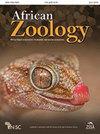炎热和棘手:环境温度升高时,巨型史矛革蜥蜴粪便糖皮质激素代谢产物浓度的变化
IF 0.5
4区 生物学
Q4 ZOOLOGY
引用次数: 1
摘要
尽管人们普遍认为爬行动物对极端温度免疫,但预计到2080年,全球变暖将导致40%的爬行动物物种灭绝。为了了解高温对非洲爬行动物生理和健康的影响,还需要进行更多的研究。我们研究了在圈养环境中面对高温的太阳蜥蜴(Smaug giganteus)的生理应激反应。在整个13周的研究期间,对照动物(1M,2F)被保持在30°C。试验动物(1M,2F)暴露于30°C下4周(第1阶段)、39°C下6周(第2阶段)和30°C上3周(第3阶段)。从对照动物和试验动物身上采集粪便样本,以监测作为生理应激指标的粪便糖皮质激素代谢产物(fGCM)浓度。尽管对照雌性的fGCM水平保持不变,但随着温度的升高和随后的降低,试验雌性的fGC M水平急剧增加。与第1和第2阶段相比,受试雄性在第3阶段的fGCM水平明显更高。对照雄性尽管在整个研究过程中表现出恒定的fGCM水平,但其fGCM含量高于测试雄性。结果表明,环境温度的显著暂时升高并没有导致太阳蜥蜴的肾上腺皮质活性长期升高。物种内部的固有特征很可能使物种能够适应这种变化。此外,由于该物种的濒危状态和研究动物的有限可用性,本研究的样本量仅限于少数圈养蜥蜴。因此,尽管我们的研究结果是爬行动物保护的重要补充,但应该谨慎地将其外推到自由放养的种群中。未来的研究应该考虑长期高温对水和食物短缺的影响,以及生理反应的个体间变化。本文章由计算机程序翻译,如有差异,请以英文原文为准。
Hot and Bothered: Alterations in Faecal Glucocorticoid Metabolite Concentrations of the Sungazer Lizard, Smaug giganteus, in Response to an Increase in Environmental Temperature
Despite the commonly held belief that reptiles are immune to extreme temperatures, global warming is predicted to result in the loss of 40% of all reptile species by 2080. In order to understand the effects of elevated temperature on African reptile physiology and health, additional research is required. We studied the physiological stress response of sungazer lizards (Smaug giganteus) facing elevated temperatures within captivity. Control animals (1M, 2F) were kept at 30 °C throughout the 13-week study period. Test animals (1M, 2F) were exposed to 30 °C for four weeks (stage 1), 39 °C for six weeks (stage 2) and 30 °C for three weeks (stage 3). Faecal samples were collected from both control and test animals to monitor faecal glucocorticoid metabolite (fGCM) concentrations as a proxy of physiological stress. Although the fGCM levels of control females remained constant, test females showed an acute fGCM increase following the increase and subsequent decrease of temperatures. The test male had significantly higher fGCM levels during stage 3, compared with stage 1 and 2. The control male, although displaying constant fGCM levels throughout the study, had higher fGCM levels than the test male. The results indicate that a considerable temporal increase in environmental temperature did not lead to chronically elevated adrenocortical activity in sungazer lizards. It is likely that inherent traits within the species allow the species to adapt to such changes. Furthermore, the endangered status of the species and limited availability of study animals restricted the sample size in this study to a few, captive-based lizards. Therefore, although our results are an important addition to reptile conservation, they should be extrapolated to free-ranging populations with caution. Future research should consider the effects of chronically elevated temperature in relation to water and food shortages, as well as interindividual variation in physiological responses.
求助全文
通过发布文献求助,成功后即可免费获取论文全文。
去求助
来源期刊

African Zoology
生物-动物学
CiteScore
2.60
自引率
9.10%
发文量
18
审稿时长
>12 weeks
期刊介绍:
African Zoology , a peer-reviewed research journal, publishes original scientific contributions and critical reviews that focus principally on African fauna in terrestrial, freshwater, and marine ecosystems. Research from other regions that advances practical and theoretical aspects of zoology will be considered. Rigorous question-driven research in all aspects of zoology will take precedence over descriptive research. The Journal publishes full-length papers, critical reviews, short communications, letters to the editors as well as book reviews. Contributions based on purely observational, descriptive or anecdotal data will not be considered.
The Journal is produced by NISC in association with the Zoological Society of South Africa (ZSSA). Acceptance of papers is the responsibility of the Editors-in-Chief in consultation with the Editors and members of the Editorial Advisory Board. All views expressed are those of the author and not necessarily those of the Editors or the Department.
 求助内容:
求助内容: 应助结果提醒方式:
应助结果提醒方式:


